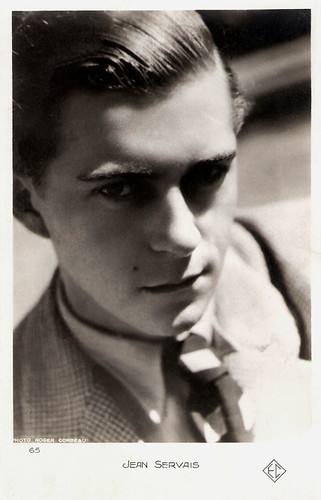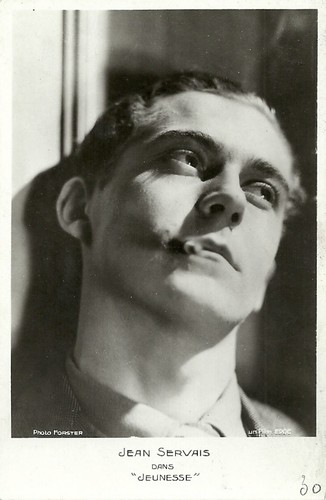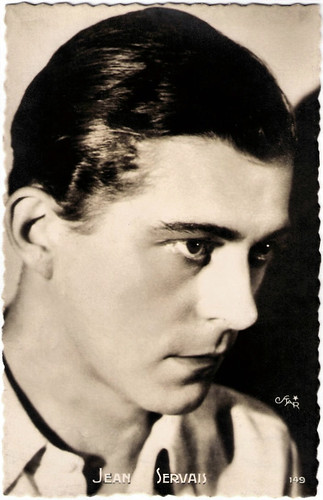
French postcard by Editions et Publications cinématographiques, no. 38.

French postcard by EC, no. 65. Photo: Roger Corbeau.
Victim of an Error
Jean Servais was born in Antwerp, Belgium, in 1910.
He was trained for acting at the Brussels Conservatoire (Brussels Conservatory of Dramatic Arts), where he won the Second Prize.
His acting skills came to the attention of Raymond Rouleau, and he was hired at the Théâtre du Marais, where he acted in Le mal de jeunesse, which was successful in Brussels and in Paris.
Later he was a member of Jean-Louis Barrault's theatre company for a time.
His first film role was as the simple country dweller who was the victim of an error by the justice system in Criminel/Criminal (Jack Forrester, 1932).
He had his breakthrough as Marius in a classic version of Les Misérables (Raymond Bernard, 1934) starring Harry Baur as Jean Valjean.
Other popular films were Jeunesse/Youth (Georges Lacombe, 1933), Angèle/Heartbeat (Marcel Pagnol, 1934) with Orane Demazis and Fernandel, and La Vie Est Magnifique/Life is wonderful (Maurice Cloche, 1938)
His film career was interrupted for several years by the Second World War. By the time he had returned before the cameras in 1946, he had acquired a brooding, haunted demeanor which lingered until the end of his days.
He played supporting roles Une si jolie petite plage (Yves Allégret, 1948) starring Gérard Philipe, and Le Plaisir (Max Ophüls, 1952), based on the stories by Guy de Maupassant.

French postcard. Photo: Forster / Films Epoc. Jean Servais in the film Jeunesse (Georges Lacombe, 1934),

French postcard by O.P. Paris, no. 149. Photo: Star.

French postcard by Deshairs, Grenoble, no. 65.

French postcard by A.N., Paris, no. 1019. Photo: Intran Studio.
Major Stardom
Jean Servais achieved major stardom in mid-life in Du rififi chez les hommes/Rififi (Jules Dassin, 1955), in which he played the tough, straight-talking leader of a gang of jewel thieves.
This crime drama about the planning and execution of a nighttime robbery at a swanky English jewelry shop in the Rue de Rivoli is seen by many critics as a landmark caper film.
Lucia Bozzola at AllMovie: "The pinnacle of heist movies, blacklistee Jules Dassin's Du Rififi Chez Les Hommes (1955) is not only one of the best French noirs, but one of the top movies in the genre. Crafting an archetypal noir story about how human weakness can sabotage the best-laid."
Du rififi chez les hommes/Rififi became an oft-imitated international hit and Jules Dassin won an award at the Cannes Film Festivan for his direction.
Servais and Dassin reunited for Celui qui doit mourir/He Who Must Die (Jules Dassin, 1957) with Carl Möhner and based on Nikos Kazantzakis's novel O Hristos Xanastavronetai.
Jean Servais is also known for his film association with such directors as Luis Bunuel (La fièvre monte à El Pao, 1959) and Georges Franju (Thomas l'imposteur, 1964).
In the 1960s, Servais took small character roles in popular international fare such as The Longest Day (Darryl F. Zanuck, 1962) and L’ homme de Rio/That Man from Rio (Philippe de Broca, 1964) starring Jean-Paul Belmondo.
In his last film, Le Protecteur/The Protector (Roger Hanin, 1974), he was a recently-released prisoner who tries to find his daughter who has fallen into the underworld of prostitution.
Jean Servais died of a heart failure in Paris, France, in 1976. He was married twice: to actress Dominique Blanchar and to Gilberte Graillot.

French postcard by Editions P.I., Paris, no. 155. Photo: Star.
French postcard by Editions P.I., Paris, no. 641, offered by Les Carbones Korès 'Carboplane'. Photo Studio Vallois.
Sources: Lucia Bozzola (AllMovie), AllMovie, IMDb and Wikipedia.
5 comments:
New info about old times at the cinema...
Bob, it depends on the postmark date if the maximum cards are really vintage.
He has amazing eyes.
Great card. Happy PFF!
Very intense gaze.
Great video clip... love the post... Always enjoy the bit of history you share about each of the stars!
Thanks for stopping by and checking out my PFF post! Happy PFF
A very good-looking actor. The video clip was amazingly good quality I thought.
Post a Comment